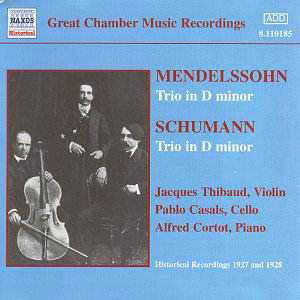When an admirer thrust a tiny scrap of paper into his
hands and asked him to write something the French violinist Jacques
Thibaud, at a loss, turned nonplussed to a colleague and shrugged despairingly.
"Just write your repertoire, Jacques," he was told. Or so
itís said. Itís true that Thibaudís repertoire was small and so was
that of the Trio of which he was a member for twenty-nine years. The
trio began in 1905 in Paris, at first privately and then with increasing
success and enthusiasm the three began to give soirées and then
the first of their concerts, in 1907. The extent of the works they performed
was, in fact, precisely thirty-three of which at least half were discarded
after a few or even just one performance. This, in essence, meant that
they had as their core repertoire the Beethoven Op 70, Schumann Op 63,
Mendelssohn, Haydn G Major and Gypsy Rondo and Schubert B Flat. Their
last performance, in 1934, was a private one, in Florence, after which
Casals, now too busy, gave up his place, which was for a time filled
by Pierre Fournier. Casalsí political views led to the later famous
breach with Cortot and Thibaud; Cortot, who had played concerts in Germany
during the War, apologized and was forgiven, whereas Thibaud declined
to genuflect to Casals and was not.
Their London debut came in 1925 and was followed over
the next few years by recordings of their major works. They have all
been reissued many times in differing couplings. Here the Mendelssohn
from 1927 is coupled with the Schumann which was recorded the following
year, entirely apt disc mates and a good start to what will be Naxosís
traversal of the complete trio recordings. These famous records show
how disparities in tonal weight are not necessarily prohibitive of lyrical
phrasing, how Thibaudís beautifully elegant but concentrated tone contrasts
with Casalsí big tone. Not the least of the contrasts comes in passages
in which the fixity of the cello bass line underpins Thibaudís spinning
of a melody, accompanied all the time by Cortotís triumphant pianism.
The opening of the Mendelssohn is a case in point Ė with Casals deep,
rather gruff lower two strings and Thibaudís quick, light tone making
their unique tonal blend. Thibaudís portamento here is not only quite
characteristic of him but itís also entirely in keeping with their Mendelssohn
playing which is romantic and flexible. The violinistís playing of the
passage from 5í10 in this movement is ravishingly beautiful. In the
Andante Cortot animates his partners with his acute rhythmic left hand
accents and there is an unforced almost spontaneous elegance to the
ensemble. There is much propulsive warmth in the finale with the unison
passages almost revelling in those tonal disparities between the string
players. The Schumann, a more elusive work, is notable for the metrical
freedoms of all three musicians in an opening movement which is both
slow and involved. There are some superb sonorities in the more mysterious
sections of the first movement with all scaling down their playing to
prodigious effect. The slow movement is broad but well sustained whereas
the finale is quiveringly vital, with some real con fuoco phraseology
and a momentum that surges towards a grandly rhetorical conclusion.
The transfers by Ward Marston are excellent and Tully
Potterís notes cover the ground well.
Jonathan Woolf


![]() See
what else is on offer
See
what else is on offer 